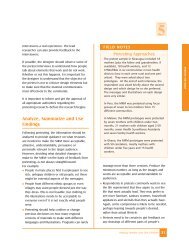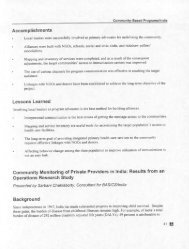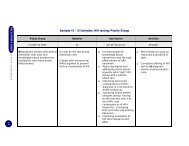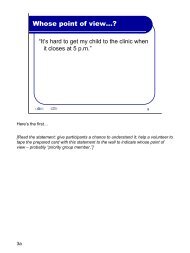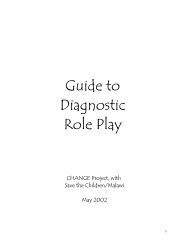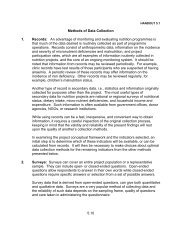MODULE TWO: COUNSELLING - FHI 360 Center for Global Health ...
MODULE TWO: COUNSELLING - FHI 360 Center for Global Health ...
MODULE TWO: COUNSELLING - FHI 360 Center for Global Health ...
You also want an ePaper? Increase the reach of your titles
YUMPU automatically turns print PDFs into web optimized ePapers that Google loves.
Following is a summary of the TASO process, which was developed by The AIDS<br />
Support Organisation (TASO) in Uganda. It has been modified slightly <strong>for</strong> use by<br />
telephone counsellors.<br />
STAGE I: Welcoming and building a relationship<br />
The goal of this step is to establish a relationship with the client through putting him at ease<br />
and building his trust.<br />
This is a very important stage, because it sets a good atmosphere and builds a<br />
foundation <strong>for</strong> the rest of the call. Specific things that a counsellor does during<br />
this stage include….<br />
♦Greeting the client in friendly manner that conveys that you are willing to listen<br />
in a non-judgmental way;<br />
♦Explaining the types of services that the YEF HIV/AIDS Hotline can offer;<br />
♦In<strong>for</strong>ming the client that everything said will be kept confidential;<br />
♦If necessary, setting boundaries <strong>for</strong> the call (i.e. <strong>for</strong> repeat callers).<br />
STAGE II: Gathering in<strong>for</strong>mation about the clients’ situation<br />
The goal of this stage is to learn about the client’s “story”. The counsellor helps the client to<br />
talk about his problem, explore his feelings and reflect on his situation.<br />
This is the “heart” of the counselling process. The counsellor tries to get the<br />
client to talk as much as possible in order to explore his situation and express his<br />
feelings.<br />
Things that the counsellor does during this stage include:<br />
♦Encouraging dialogue<br />
♦Probing <strong>for</strong> more in<strong>for</strong>mation<br />
♦Active listening<br />
♦Reflecting<br />
♦Speaking simply<br />
♦Affirming<br />
This is when the counsellor invites the client to share what problems s/he is<br />
facing. The counsellor helps the person by listening carefully, checking<br />
understanding, and asking open-ended questions to help the person explore and<br />
clarify fully. This is also the time when the client explains how s/he tries to cope<br />
with the problem.<br />
Session 3 – Pg. 5



